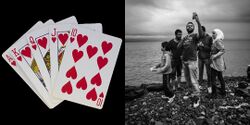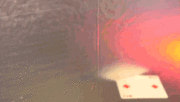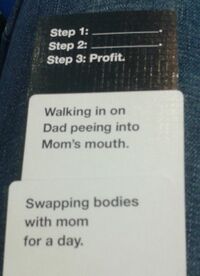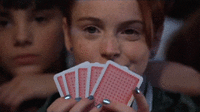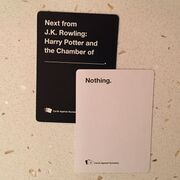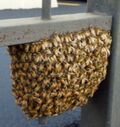Cards Against Humanity
Cards Against Humanity is a cruel, deadly game that pits two warring parties -- cards and humanity -- against one another to fight to the death. In an especially cruel fashion, said death rarely occurs in a physical or bloody manner, but instead consists of a victim keeling over and kicking the bucket out of sheer embarrassment, or sometimes, on rare occasions, laughing to death. This makes it a highly popular form of entertainment at college parties and other such social gatherings.
The titular cards come packaged in an unadorned black box. This stark, minimalist design, which evokes the image of an alien monolith looming sinisterly on the horizon, is intended to remind any observer that they are merely a fragile meat-sack staring constantly into the void of death. The game itself, likewise, revolves around this grim principle. Any seasoned player of Cards Against Humanity is well aware that on any day, at any moment, their time may come, be it by chainsaws, sharks, the Care Bear Stare, or... bees?
A boxed set of the game can often be found in the common college dorm or apartment, resting in plain sight on a shelf in the TV cabinet. The idea behind this is much the same as that of ancient philosophers who kept a skull on their desks, thus keeping the concept of death ever fresh in their minds. This placement also makes it quite convenient to pull out and set up during a party. Often, apartment guests will spot the black box and, suddenly overcome by a cosmic sense of the connectedness of all things and the futility of life itself, will announce something along the lines of, "Hey, guys, wanna play Cards Against Humanity?" -- knowing full well, of course, that embarrassment, ridicule, vomiting, diarrhea, and death will certainly follow, for the cards never fall in the favor of humanity.
History
Ben Hantoot and Max Temkin, two young men, set out to create the game in 2011, out of boredom and general disillusionment with life in general. Being virgins, they also happened to be fans of such games as Magic: The Gathering, Balderdash, and Mad Libs. In the previous year, Hantoot and Temkin were in the midst of a rollicking game of Apples to Apples in their fraternity house when, out of rage, a player named Abe Bundaberg took forth his card and threw it, discus-style, straight into the jugular of a fellow player, Ricky Fry. The sharpened edge of the card cut Fry's head clean off. Though he was rushed to the hospital, doctors failed to reattach his cranium.
Inspiration strikes
At Fry's deathbed, Hantoot and Temkin agreed between themselves that what they had witnessed was the deadly, corrupting nature of humanity's greatest threat -- cards. Temkin, interviewed, later claimed that "[he] saw the card cut through the air like a bat from hell, red with bloodlust ... nothing stopped it from taking the human life before it." Hantoot added that "He [Bundaberg] was no killer. Abe wouldn't have done that if not for the game we'd been playing, the card in his hand. It was a 'Goldie Hawn' card. He hadn't been able to get rid of it for the entire game. Really, what earthly adjective even describes Goldie Hawn? That game was designed to make murderers of us all."
The two initially thought of starting a campaign to have Apples to Apples banned in their home state of Illinois, but their first few protests were unsuccessful; unwittingly, they had scheduled their picket displays on the same day the Illinois Nazi Party was marching through Main Street. Later, they realized that they were approaching the problem from the wrong angle entirely. Where they had once grieved, Hantoot and Temkin began to see a sort of "savage beauty" in the horrible, deleterious nature of card games; a beauty "like that of a leopard seal sinking its teeth into a penguin chick." Thus, they formed a grand plan to create a new game, a masterpiece of stark terror that would showcase the horrible way that cards were plotting against humanity. Fittingly, they christened their creation...
...Cardenfreude. But this name didn't catch on, so they quickly revised it to a more gripping moniker, Cards Against Humanity.
A success in crowdfunding
They funded their creation through the miracle of crowdsourcing; Temkin's roommate, Ronald Smarts, had been recently obsessed with a book about Obama funded in this manner, so he concluded that if such drivel could get funded that way, their work of fine art would be able to accomplish the same with ease. They met their fundraising goal of 4,000 dollars in a mere two weeks. Some who donated said they were convinced to give money by the moving, poetic meditation on death and evil that was Cards Against Humanity; others simply felt sorry for the late Ricky Fry and his family.[1]
Gameplay
Just as a heartless massacre can claim any number of victims, Cards Against Humanity can be played by a group of any size. At the outset, each player draws ten white cards, the pallid color of these representing humanity's fragile light, like a candle flickering alone in the dark, besieged by death's cold winds.
Dump Clause
As per the rules, the first person to make a move is the person who most recently took a dump. This standard of practice, as co-creator Ben Hantoot explains, "came to me as I meditated on the way feces reminds us all of our inevitable demise. The stink, the way no one wants to look at it -- it's just like a corpse." Resultantly, he who most recently sat upon the porcelain throne is deemed the one closest to death, and thus he shall first take up the mantle of the Card Czar.
Tyranny of the Czar
The Card Czar[2] is the player responsible for the grim task of drawing a black card -- its own coloring a reference to death's shadowy cloak. These cards contain questions or fill-in-the-blank phrases, which often drive those who hear them to madness. It is the role of all other current players to choose a white card whose inscription best answers the question or completes the phrase, if such a thing is at all possible. Often, players will howl and thrash in frustration, as none of the white cards in their possession come close to answering the devious riddle the Card Czar has presented them with.
Once all players have presented the white cards of their choice, it is the Czar's responsibility to choose the answer that best fits the question his black card posed. Just as all is fair in love and war, the Czar is by no means required to adhere to the rules of logic and reason when making his choice; ultimately, he may choose whatever answer he pleases.[3] The proud and fortunate winner may then keep the black card as a reminder of the joyous hour in which the Czar was merciful to him.
Terror by numbers
Sometimes the Card Czar's black card of choice will require players to put two or three cards into play at once. This is sure to cause only additional confusion and hysteria. Expect to see your fellow players gnaw off their fingernails one by one as they wait in anticipation, hoping and praying that the merciful Czar will read their answers in the order they intended.
The endgame
The rules do not state how to win the game. Just as life itself has no real objective, neither does Cards Against Humanity.[4]
Reception
Cards Against Humanity quickly became the best-selling game on Amazon. As people all over the world became captivated by the game that confirmed all their worst assumptions about human nature, it became something of a craze. It earned a profit of roughly $12 million, and multiple cities have reported instances of the game being stolen from local shops, as even the most desperate of thieves have become determined to try their hand at "The Devil's Game."[5]
At the annual IndieCade games festival in Culver City, California,[6] the first expansion to the game was announced. In addition to one hundred new cards, the expansion pack contained twelve blank ones, on which players could devise their own answers to the game's insanity-inducing riddles. Hantoot and Temkin stated that this expansion would "allow all of us, every speck of the common human filth, to participate in this great work of art." However, most people simply created cards bearing their ethnic friends' names, with which to respond to prompts such as "I'm not racist or anything, but I really don't like _____" -- giving in, as expected, to the tendencies of all humans to throw others under the bus for their own personal gain.
Promotional strategies
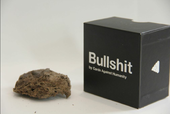
The creators of Cards Against Humanity have gained infamy for the great lengths they go to in order to promote their product. Many of these publicity stunts occur fittingly on Black Friday, a day that they feel expresses the worst of humanity's primal greed. Quoth Ben Hantoot, "If they're going to beat doors down and brawl to the death at Walmart, they might as well do it for a product that'll really make them think about their human flaws and their inevitable mortality."
In the first of these promotions, intended to prove that nothing could stop the human race from chasing after a close brush with death, they raised the price of the game by five dollars for a limited time. As expected, sales did not fall. People clambered over each other, trampling their fellow men underfoot, for the chance to spend an extra five dollars on that fabled black box; since it was apparently worth more all of a sudden, most concluded that they simply had to buy it, or all their friends would scorn them as cheapskates.[7]
The following year, to further prove this point, Hantoot and Temkin pulled all boxed copies of the game from stores, instead shipping out boxes of literal bull feces. There was nothing duplicitous or sneaky about it; the writing on the box simply read "Bullshit." Yet millions were sold. One customer, Tim Schechter, contracted cholera from the poop, but later, when asked whether he'd sue, he stated, "Nope. My life was already goin' down the shitter. This won't change much."[8]
Next year, they held a sale of nothing -- literally nothing, for five dollars. They made the official statement that “on Black Friday, everybody is selling something. We’re the only company to offer the superior Black Friday experience of buying nothing." They made $71,000.
Chips
In 2017, Cards Against Humanity made the bold move of expanding their brand, making an entrance into the chip market. They did so with Prongles, a new breed of snack food crafted from a new breed of pig, which Hantoot and Temkin had created themselves, with the help of of geneticist Josh Dillon. Dillon snuck behind the podium at a Trump rally and stole a hair from the president's head; this gave him a sample of DNA to work with. He spliced the Trumpian genes into the developing fetus of a common pig, which later grew into an all-new specimen that sported a pompous golden coif.
The pig, much to its own chagrin, was later skinned alive. The Cards Against Humanity creators proceeded to fry thin strips of its skin into the new snack they had envisioned. Marketing for the snack touted the inclusion of President Donald Trump's genes in its recipe: "Ever wanted to bite into Donald Trump? Now you can!"
It's unclear to this day whether the company aimed this campaign at supporters or critics of the President. Prongles, nonetheless, tasted terrible, and were soon discontinued.
Land purchases
In 2017, the company entered a crisis of sorts: their massive stockpiles of nothing, which they had produced en masse to meet the demands of nothing-hungry customers, were clogging up their warehouses, and they needed a place to keep it all. To meet this need, they ended up purchasing a large plot of land along the U.S.-Mexico border. Being featureless wasteland, this plot was dirt-cheap, and as they had made scores of money off their anti-sales and bullshit packages, such a purchase was essentially chump change to them. Immediately, Cards Against Humanity shipped all of its nothing to the newly-purchased land, stacking it up right on the desert sand.
This sudden purchase aroused the ire of the Trump administration, busy at the time with the construction of a wall along the border. Upon reaching Hantoot and Temkin's lot of nothing, the construction crew could build no further, and found themselves at a loss for what to do about it. A few workers even bumbled into the massive stacks of nothing, not realizing it was there until it was too late and their noses were broken.
Preparing for the worst, the company began to invest its funds into legal defense for its borderland nothing stores. When their monetary reserves ran out, they introduced a new product for purchase: a certificate good for multiple mystery gifts, sold for $15 each. Most of these gifts were tightly-packed boxes of nothing, as this was the only real asset the company had to sell. However, a few recipients did report that they found toilet paper or dried kidney beans in the boxes they received.
To this day, Trump and his cronies have found no reasonable means of dealing with the land that stands in their way. A few workers have humbly made the suggestion of building the wall around it, but the president has consistently shot their pleas down, citing his unwillingness to "listen to the grumbling of filthy peasants."
Bees
Bees?
Notes
- ↑ Though the mention of this netted Temkin and Hantoot a ton of money from sympathizers, not a penny they earned went to Fry's still-grieving parents.
- ↑ Or Card Tsar, depending on your preferred spelling.
- ↑ Technically, it isn't outside the question for players to make appeals to sway the Czar toward their answer, but the Czar, ruthless and tyrannical as he is wont to be, rarely considers the pleas of the peasants.
- ↑ If players are pressed for time, though, they can simply call the last participant to keep his or her sanity the winner.
- ↑ This title had previously belonged to the notorious card game Phase Ten, but most now agree that Cards Against Humanity has deservingly usurped it.
- ↑ It is said that multiple ley lines pass through Culver City, resulting in its choosing for this sacred festivity.
- ↑ Other businesses, such as Costco and Pornhub, have since adopted "anti-sales" such as these for their own trades, to varied results; as one disgruntled customer said, "I don't care what it's worth, I ain't never payin' for no goddamn porn!"
- ↑ Schechter died the following day, not from the cholera, but by being kicked in the forehead by a horse.
- ↑ Note: the small fence pictured here is not Trump's wall, but a barricade erected by Hantoot and Temkin as a warning against would-be nothing thieves.
| Featured version: 10 October 2019 | |
| This article has been featured on the main page. — You can vote for or nominate your favourite articles at Uncyclopedia:VFH. | |
